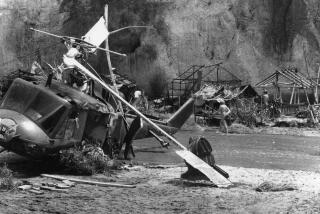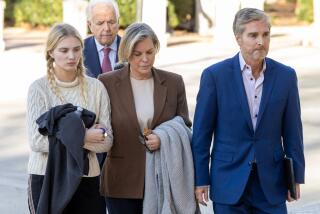For Exhausted Jurors, ‘It Was Hard . . . It Was Very Emotional’
- Share via
First they sat patiently through a complex 4 1/2-month trial, listening to testimony from scores of witnesses and arguments from a dozen attorneys.
Then, the jury of seven women and four men deliberated for 46 hours over 10 days, quarreling at times as they tried to decide who was to blame for the 1986 midair collision that killed 82 people in 1986.
Martha Wade, a juror from Anaheim, said that despite the tense deliberations, the jurors “were friends to the end.” Some jurors embraced in the jury’s chambers after the unanimous verdict was read Friday, and one juror said she might plan a reunion.
“It was hard . . . it was very emotional,” said Martha Soto, a worker at a Barstow department store. “I’m feeling like Jell-O right now.”
Difficult Part
Soto said the jurors decided who was responsible for the accident after the first five days of deliberations. The most difficult part, she said, was determining the percentage of liability.
Juror Coleen Page of Diamond Bar told attorneys for the plaintiffs that the jury split into various camps on the issue. Some jurors argued that the Federal Aviation Administration should be held more responsible for the accident, she said, while others wanted to place more of the blame on William K. Kramer, the pilot of the small Piper Archer that collided with an Aeromexico DC-9.
In the end, the exhausted jurors arrived at what some observers called a Solomon-like decision, splitting the blame evenly between the two defendants. The jury absolved Aeromexico of any blame in the collision.
“I felt that there was always the possibility that they (the Aeromexico crew) could not have seen that small plane,” said juror Valorie Mitzel of Anaheim, the former head of a nonprofit organization. “We couldn’t find anything to say they were goofing off or being anything less than vigilant.”
Attorneys for Kramer’s estate argued that the pilot had suffered a heart attack moments before drifting into the path of the airliner, but the jurors were not convinced.
“Everybody talked about it, but we felt that he really didn’t have a heart attack,” Martha Wade said. “We never really believed the theory.”
Lawyers for the crash victims contended that air traffic controller Walter White was to blame for the accident because he should have spotted Kramer’s plane on his radar screen.
Page said she believed that Kramer’s plane was on White’s radar screen, but that the traffic controller “just didn’t see it.”
But Mitzel was less charitable, saying the controllers were “too casual” about their responsibilities.
“The workload was very light that day. It’s expected of the air traffic controllers to be able to handle the traffic,” she said.
U.S. District Judge David V. Kenyon praised the jury for its “serious” approach to the deliberations and called them “a wonderful group.” He later decided to uphold their verdict.
After leaving the Los Angeles Federal Courthouse Friday to have lunch together at a restaurant in nearby Little Tokyo, the jurors seemed relieved that the long trial was over. One juror was dismissed during the case because of an illness in the family.
Several had commuted to the courthouse from Orange County, while Soto spent weekdays at the home of her mother in the Los Angeles area, returning to Barstow only on weekends.
Soto said that although she has never flown in a plane, she will not be deterred from flying, despite hearing testimony about the crowded air corridors over the Los Angeles Basin.
“It didn’t advise me against flying,” she said. “It’s as safe as it can be.”
More to Read
Sign up for Essential California
The most important California stories and recommendations in your inbox every morning.
You may occasionally receive promotional content from the Los Angeles Times.














